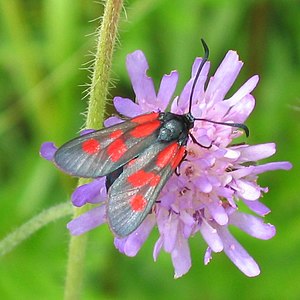Little pentagon ram
| Little pentagon ram | ||||||||||||
|---|---|---|---|---|---|---|---|---|---|---|---|---|

Little pentagonal ram ( Zygaena viciae ) |
||||||||||||
| Systematics | ||||||||||||
|
||||||||||||
| Scientific name | ||||||||||||
| Zygaena viciae | ||||||||||||
| ( Denis & Schiffermüller , 1775) |
The little five-spotted ram ( Zygaena viciae ) is a butterfly ( moth ) from the ram family (Zygaenidae).
features
The moths reach a wingspan of 22 to 32 millimeters and are therefore significantly smaller than the similar rams. They also have a more delicate physique. As with all red rams, their slightly translucent wings are black and have a slight greenish tinge. On each of them five, very rarely six, sometimes elongated red spots can be found. But these have less contrast than the other rams. The third spot is very small. The hind wings have a black wing edge, this is wider in the males than in the females. The antennae are thin and very short. Its tip is widened to form a piston that is, however, flat.
The caterpillars are about 18 millimeters long and have short white hairs. They are whitish-light green in color and have a white topline. There are two small black dots on either side of each segment, the outer one being significantly smaller. Just below the line with the larger dots runs a white longitudinal line, which is interrupted by a yellow spot on the back of each segment.
Similar species
- Horn clover ram ( Zygaena lonicerae )
- Marsh horn clover ram ( Zygaena trifolii )
- Horseshoe ram ( Zygaena transalpina )
- Six-spot ram ( Zygaena filipendulae )
Occurrence
They occur in southern and central Europe , west to Scotland , in southern Scandinavia and east to Lake Baikal . They are extinct in southern England . They live on dry grass and flowering meadows as well as on forest paths and wet meadows . Along with the six-spotted ram ( Zygaena filipendulae ), they are the most common species in Central Europe.
Way of life
Flight and caterpillar times
The moths fly in one generation from mid-June to July. The caterpillars are found from August and after wintering until May of the following year.
Food of the caterpillars
The caterpillars feed on the leaves of common horned clover ( Lotus corniculatus ), seed saspars ( Onobrychis viciifolia ), bird vetch ( Vicia cracca ) and meadow pea ( Lathyrus pratensis ).
development
The caterpillars hide on the ground during the day and feed at night. They are only active on cloudy days. They overwinter and pupate in May in a boat-shaped, pale yellow cocoon that is attached to blades of grass. The doll itself is black-brown and has a yellowish white abdomen.
Hazard and protection
- Red list FRG: V (on the pre-warning list).
swell
Individual evidence
- ↑ Manfred Koch : We identify butterflies. Volume 2: Bears, Spinners, Swarmers and Drills in Germany. 2nd, expanded edition. Neumann, Radebeul / Berlin 1964, DNB 452481929 , p. 60.
- ↑ Federal Agency for Nature Conservation (Ed.): Red List of Endangered Animals in Germany . Landwirtschaftsverlag, Münster 1998, ISBN 3-89624-110-9 .
literature
- Heiko Bellmann : The new Kosmos butterfly guide, butterflies, caterpillars and forage plants . Franckh-Kosmos, Stuttgart 2003, ISBN 3-440-09330-1 .
- Hans-Josef Weidemann, Jochen Köhler: Moths, Spinners and Swarmers . Naturbuch-Verlag, Augsburg 1996, ISBN 3-89440-128-1 .
- CM Naumann, WG Tremewan: The Western Palaearctic Zygaenidae . 1st edition. Apollo Books, Stenstrup 1999, ISBN 87-88757-15-3 (English).
Web links
- Lepiforum e. V. - Photos and taxonomy
- www.schmetterling-raupe.de
- Moths and Butterflies of Europe and North Africa (English)
- Ian Kimber: Guide to the moths of Great Britain and Ireland (English)
- Zygaena viciae at Fauna Europaea. Retrieved March 14, 2011
